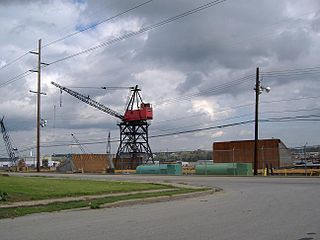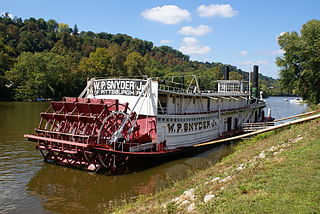
Allegheny County is a county in Pennsylvania, United States. As of the 2020 census, the population was 1,250,578, making it the state's second-most populous county, after Philadelphia County. Its county seat and most populous city is Pittsburgh, Pennsylvania's second most populous city. The county is part of the Greater Pittsburgh region of the commonwealth, and is the center of the Pittsburgh media market.

Downtown Pittsburgh, colloquially referred to as the Golden Triangle, and officially the Central Business District, is the urban downtown center of Pittsburgh, Pennsylvania, United States. It is located at the confluence of the Allegheny River and the Monongahela River whose joining forms the Ohio River. The triangle is bounded by the two rivers.
The Pittsburgh and Lake Erie Railroad, also known as the "Little Giant", was formed on May 11, 1875. Company headquarters were located in Pittsburgh, Pennsylvania. The line connected Pittsburgh in the east with Youngstown, Ohio, in the Haselton neighborhood in the west and Connellsville, Pennsylvania, to the east. It did not reach Lake Erie until the formation of Conrail in 1976. The P&LE was known as the "Little Giant" since the tonnage that it moved was out of proportion to its route mileage. While it operated around one tenth of one percent of the nation's railroad miles, it hauled around one percent of its tonnage. This was largely because the P&LE served the steel mills of the greater Pittsburgh area, which consumed and shipped vast amounts of materials. It was a specialized railroad, deriving much of its revenue from coal, coke, iron ore, limestone, and steel. The eventual closure of the steel mills led to the end of the P&LE as an independent line in 1992.

The Liberty Bridge, which was completed in 1928, connects downtown Pittsburgh, Pennsylvania, to the Liberty Tunnels and the South Hills neighborhoods beyond. It crosses the Monongahela River and intersects Interstate 579 at its northern terminus.

The South Tenth Street Bridge, most often called the Tenth Street Bridge, but officially dubbed the Philip Murray Bridge, is a suspension bridge that spans the Monongahela River in Downtown Pittsburgh, Pennsylvania.

Jeffboat was a shipyard in Jeffersonville, Indiana founded by James Howard in 1834, a builder of steamboats. The company was owned by the Howard family until it was sold leading up to World War II. Following the war, it became known as the Jeffersonville Boat and Machine Company and later changed its name to Jeffboat, the more commonly used short form of its name. The company was the largest inland shipbuilder in the United States and the second-largest builder of barges before it closed in 2018.

USS Dick Fulton was a 123-ton stern-wheel steamer used as an auxiliary vessel in the United States Ram Fleet during the American Civil War.
The Shaver Transportation Company is an inland water freight transportation company based in Portland, Oregon, United States. The company was founded in 1880 and played a major role in the development of freight transport in the Portland area and along the Columbia.

Many steamboats operated on the Columbia River and its tributaries, in the Pacific Northwest region of North America, from about 1850 to 1981. Major tributaries of the Columbia that formed steamboat routes included the Willamette and Snake rivers. Navigation was impractical between the Snake River and the Canada–US border, due to several rapids, but steamboats also operated along the Wenatchee Reach of the Columbia, in northern Washington, and on the Arrow Lakes of southern British Columbia.

The steamboat S.G.Simpson operated in the early 1900s as part of the Puget Sound Mosquito Fleet. This vessel was later renamed E.G. English.

W. P. Snyder Jr., also known as W. H. Clingerman, W. P. Snyder Jr. State Memorial, or J. L. Perry, is a historic towboat moored on the Muskingum River in Marietta, Ohio, at the Ohio River Museum. A National Historic Landmark, she is the only intact, steam-driven sternwheel towboat still on the nation's river system.

M/V Mississippi is a United States Army Corps of Engineers (USACE) towboat operating on the Mississippi River. It is the largest diesel towboat on the river.
The Pittsburgh, Virginia and Charleston Railway was a predecessor of the Pennsylvania Railroad in the U.S. state of Pennsylvania. By 1905, when it was merged into the Pennsylvania, it owned a main line along the left (west) side of the Monongahela River, to Pittsburgh's South Side from West Brownsville. Branches connected to the South-West Pennsylvania Railway in Uniontown via Redstone Creek and to numerous coal mines.

Sprague, built at Dubuque, Iowa's Iowa Iron Works in 1901 by Captain Peter Sprague for the Monongahela River Consolidated Coal and Coke Company, was the world's largest steam powered sternwheeler towboat. She was nicknamed Big Mama, and was capable of pushing 56 coal barges at once. In 1907, Sprague set a world's all-time record for towing: 60 barges of coal, weighing 67,307 tons, covering an area of 6+1⁄2 acres, and measuring 925 feet (282 m) by 312 feet (95 m). She was decommissioned as a towboat in 1948.

Emma Hayward commonly called the Hayward, was a steamboat that served in the Pacific Northwest. This vessel was once one of the finest and fastest steamboats on the Columbia River and Puget Sound. As newer vessels came into service, Emma Hayward was relegated to secondary roles, and, by 1891, was converted into a Columbia river tow boat.

The Mon Line is an 85-mile long Norfolk Southern rail line which runs along the Monongahela River for most of its route.

Nestor was a stern-wheel driven steamboat that operated on the Cowlitz and Columbia rivers from 1902 to 1929. Nestor was primarily operated as a towboat, and did most of the towing work on the Cowlitz River. During the 1920s Nestor was part of a small fleet of towboats operated out of Rainier, Oregon by Capt. Milton Smith.

La Center was a small stern-wheel steamboat that operated from 1912 to 1931, mostly on the Lewis and Lake rivers in southwest Washington, on a route to and from Portland, Oregon along the lower Columbia and lower Willamette rivers.

Joseph Kellogg was a stern-wheel driven steamboat that operated on the Willamette, Columbia, and Cowlitz rivers for the Kellogg Transportation Company. It was named after the company's founder, Joseph Kellogg (1812-1903). The sternwheeler Joseph Kellogg was built in 1881 at Portland, Oregon.

I. C. Woodward was a side-wheel packet boat launched in July 1898 by Andrew Axton & Son Co. of West Brownsville, Pennsylvania, for the Pittsburgh, Brownsville and Geneva Packet Company. She was named for ship captain Isaac C. Woodward. I. C. Woodward was 164 ft (50 m) long by 42 ft (13 m) wide with a 5 ft (1.5 m) draft. She had 50 staterooms with additional passenger room in her texas.



















